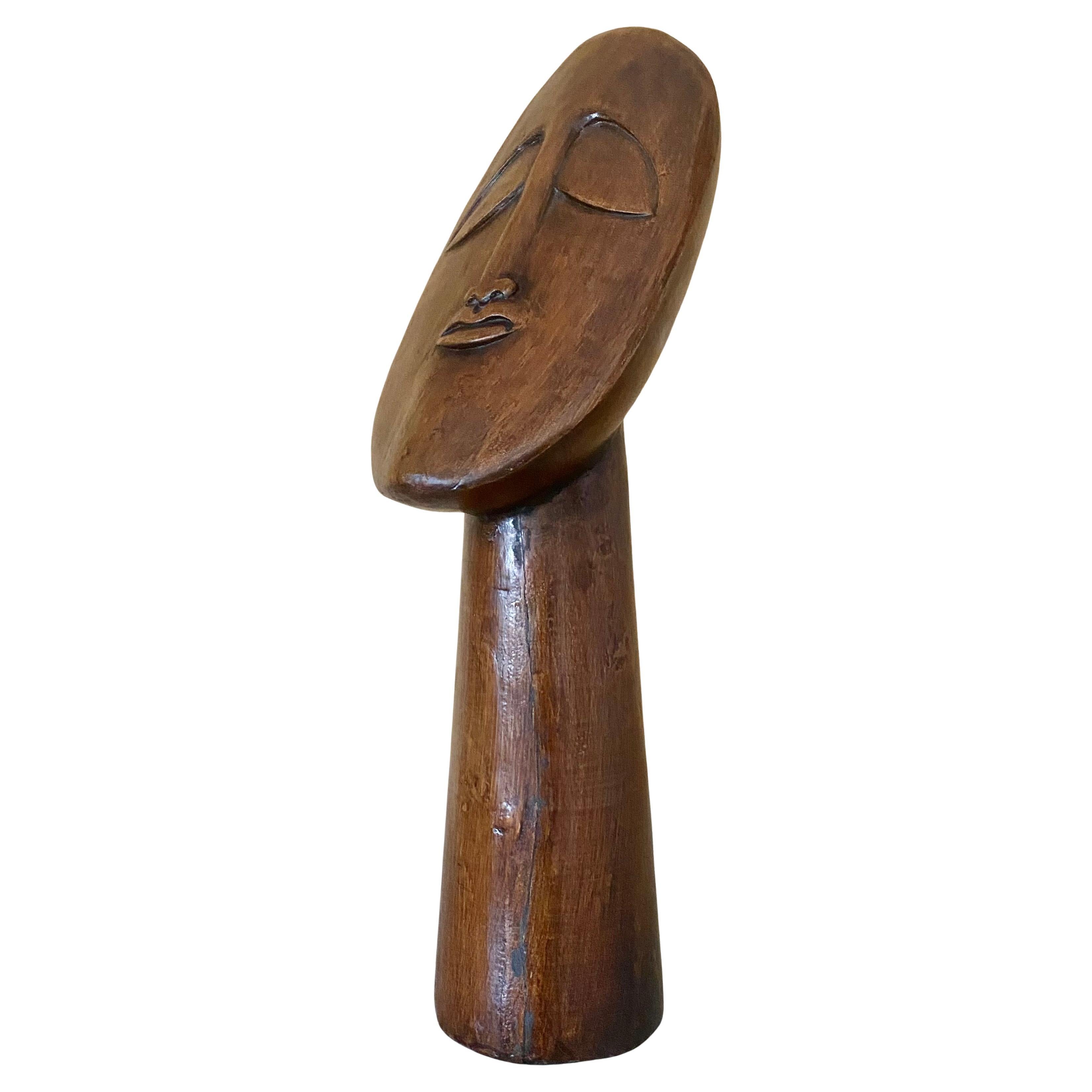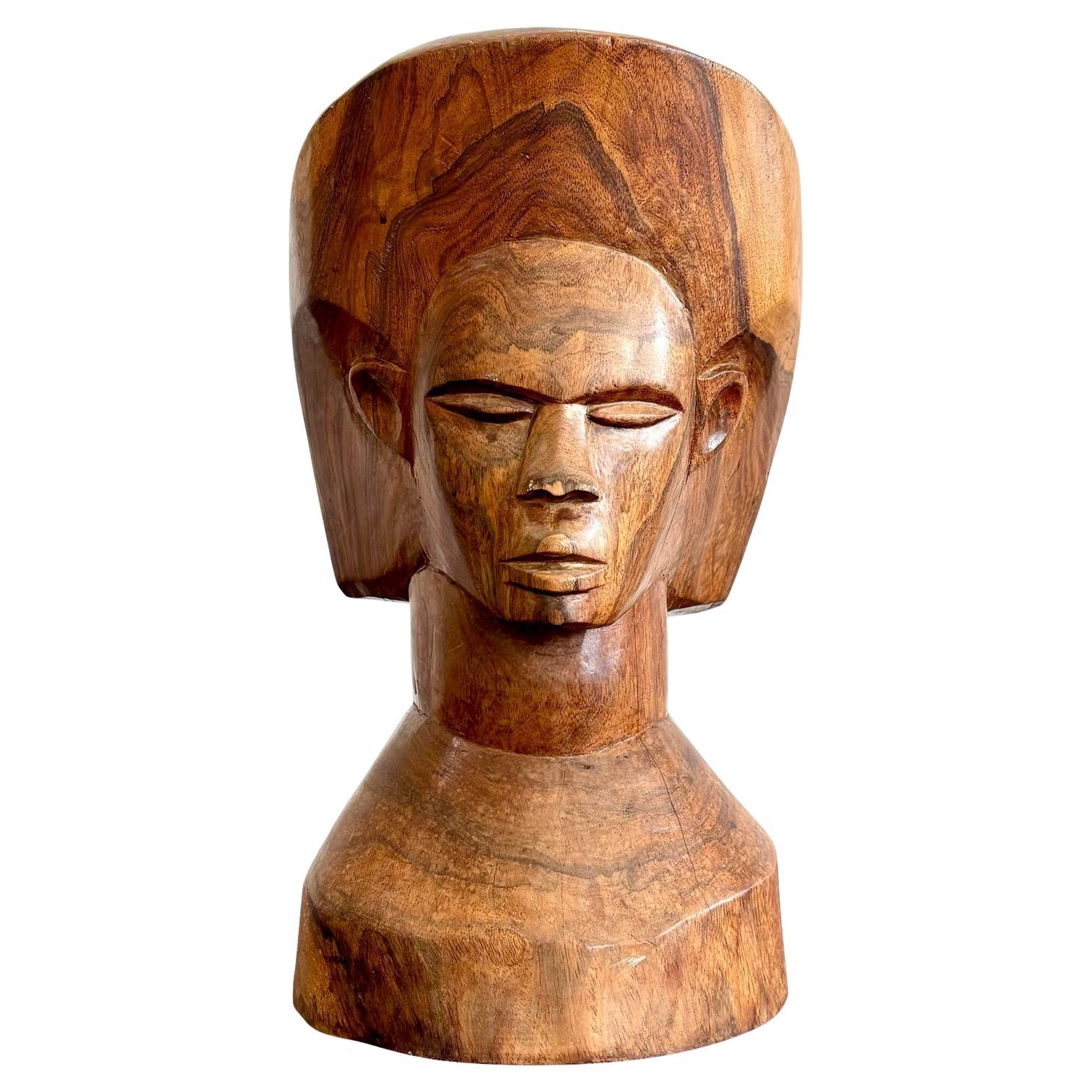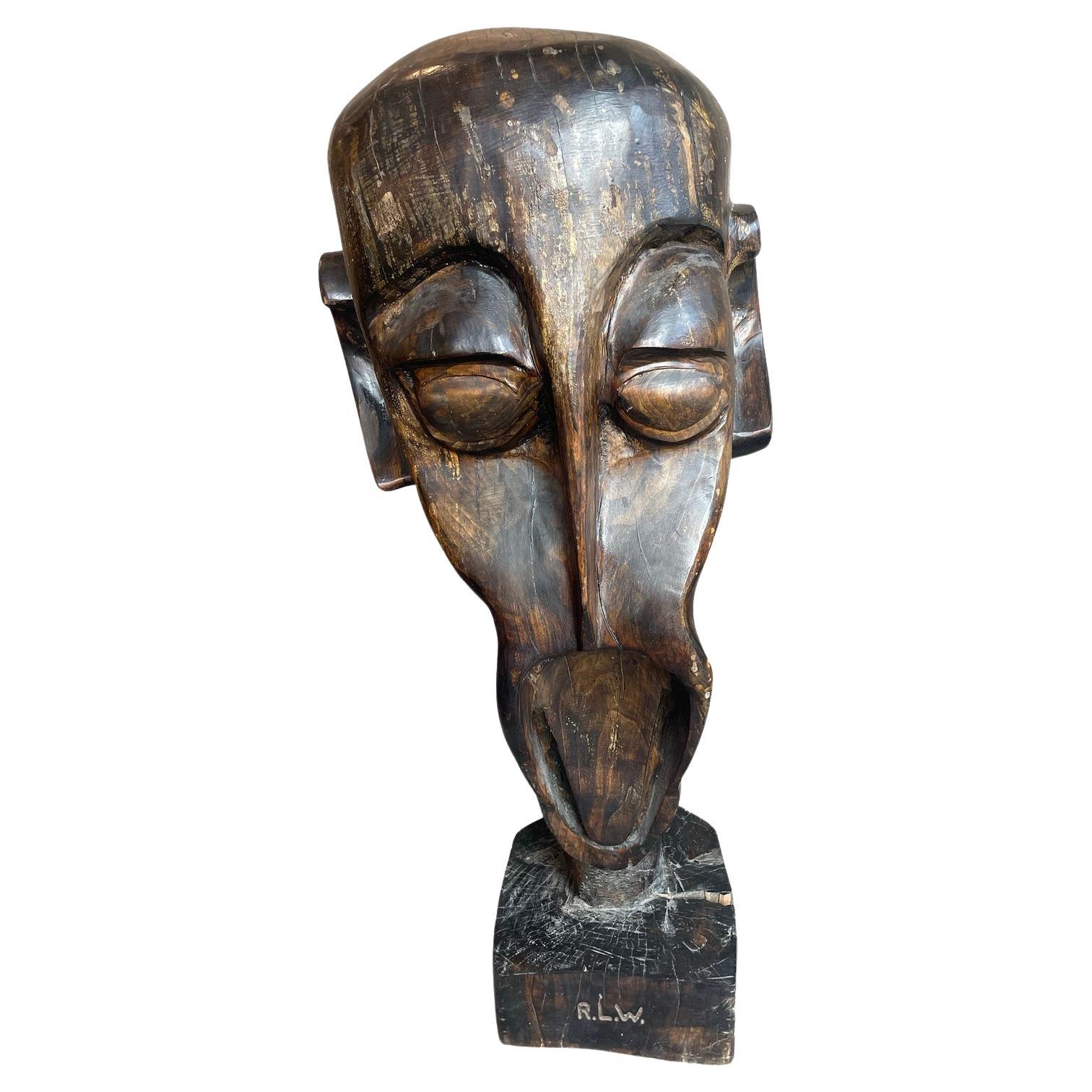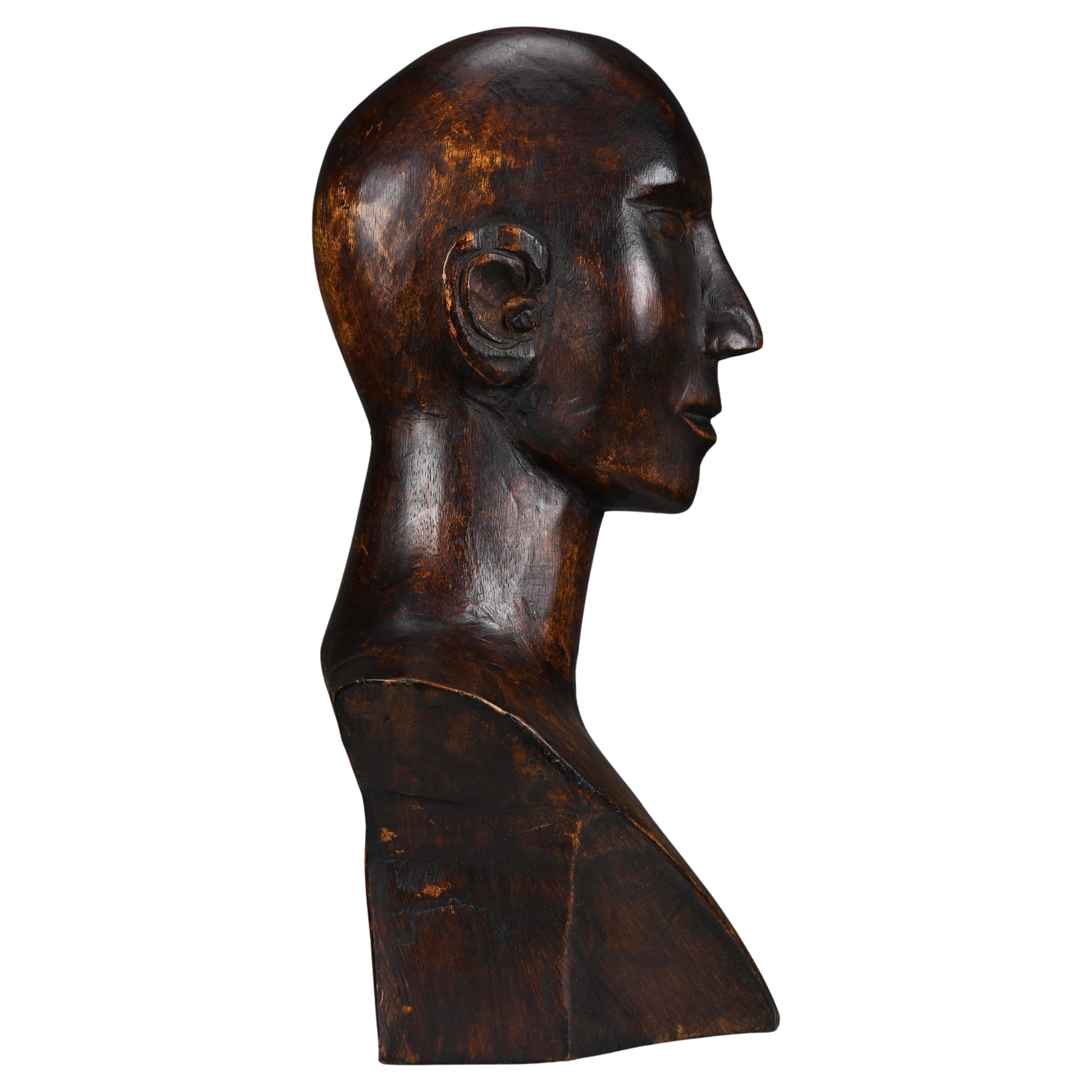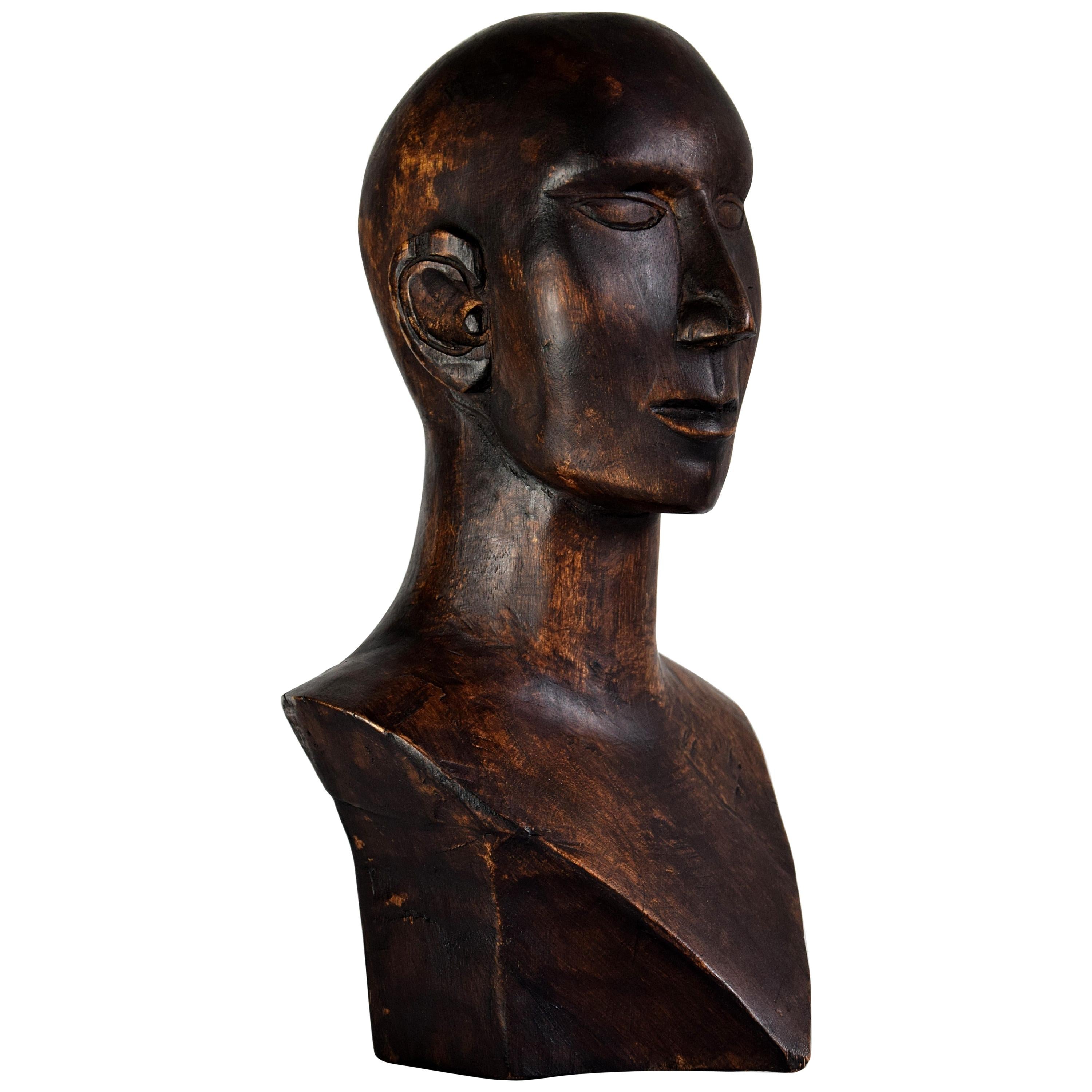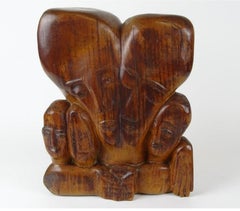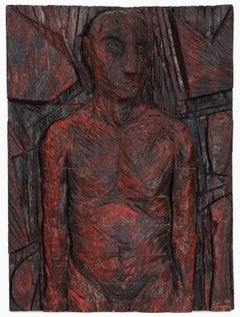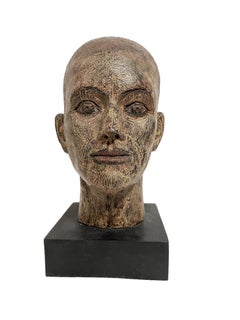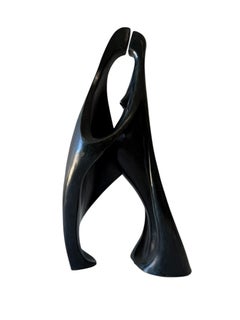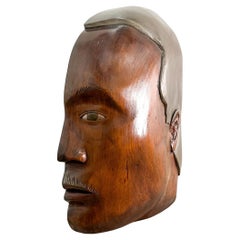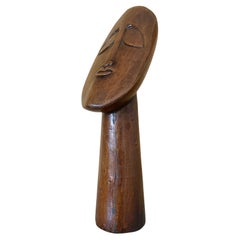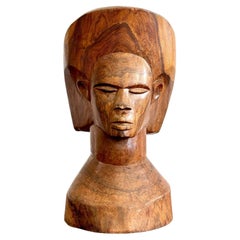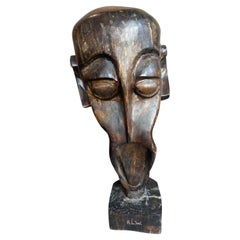Items Similar to Cuban Master Florencio Gelabert Sculpture Large Wood Carving Bust Man Portrait
Want more images or videos?
Request additional images or videos from the seller
1 of 21
Florencio GelabertCuban Master Florencio Gelabert Sculpture Large Wood Carving Bust Man Portrait1979
1979
$4,500
£3,394.16
€3,920.29
CA$6,304.81
A$7,010.59
CHF 3,670.17
MX$85,635.63
NOK 46,119.29
SEK 43,384.43
DKK 29,264.71
About the Item
Florencio Gelabert Y Perez (Cuban, 1904-1995)
Hand carved, signed; 1979
Materials: Cuban wood (mahogany?)
Dimensions 23 X 4 X 4 inches
Label affixed to underside: National Registry of Cultural Assets of the Republic of Cuba Ministry of Culture.
Provenance: Art Master Collection, Miami, Florida.
Florencio Gelabert, with a style reminiscent of Art Deco and Art Nouveau in a Latin American Expressionist stylization. Carved wood sculpture. Depicts a modernist stylized form of a man in a streamline moderne style.
José Florencio Gelabert Pérez (Caibarien, 1904 - Havana, 1995) Cuban musician, sculptor, draftsman and teacher. He graduated from the San Alejandro National Academy of Fine Arts in 1934. He received numerous awards, mentions and recognitions in Fine Arts Halls and Circles. His works are in the permanent collection of the National Museum of Fine Arts. Florencio Gelabert is a renowned sculptor, who made more than twenty solo exhibitions beginning in 1929, several in the National Museum of Fine Arts, and participated in more than thirty collectives in Cuba, Spain and Brazil, the latter in the Sao Paulo Biennial. he traveled from Caibarién to Santa Clara in 1928 to audition to enter the famous San Alejandro Fine Arts School in Havana. He obtained one of the five vacancies. Already in the Cuban capital, he combined fine arts and music. When he graduated, he became a professor in San Alejandro and the academy’s principal in 1960.
With a calling common to wood sculptors –which began with his primary school carving carpentry classes and the active life of his home town’s shipyards, his chisels and gouges feverishly turned mahogany, “ácana” and ebony into female heads with black African features dating back to 1930.
In 1938 he used his savings to explore Europe: France (Paris, Marseilles), Italy (Naples, Rome, Florence, and Venice), Belgium (Malina). His encounter with the works by Aristide Maillol, Auguste Rodin, Ossip Zadkine, Constantin Brancusi and even with Wifredo Lam, who was also born in another Cuban coastal area, Sagua la Grande, and his encounter with the nude marble David sculpture by Michelangelo all marked important points in his artistic development.
Following his European journey, his Carribean roots seemed intact. Technique filled his senses. “It was like planting ideas”, said the artist years later.
Gelabert traveled to the United States (New York, Washington, Philadelphia) in 1940. There he discovered the incalculable values of the concrete which covered large skyscrapers. Later, he was certain that the material could be used to make sculptures. Years later he lived in Mexico, where he met muralist Jose Clemente Orozco and held a personal exhibit at the Fine Arts Palace with 40 works, some of which made with the lost wax technique that he learned in the Latin American nation. The Riviera Hotel in 1957 allowed the artist to give free reigns to his imagery and show how beautiful sculptures could be made of concrete, though he preferred to make a series of bronze figures for the facility’s lobby. With the ocean as fiercely background, Gelabert designed a series of sculptures for the hotel’s entrance: a sea-horse, a nymph, a shark, dolphins, made of highly resistant direct concrete. He created La Velocidad (Speed), which decorates the entrance to Havana’s Bus Station; the Atlantico Hotel’s fountain in Santa Maria del Mar beach; the immense crab at the entrance to his hometown of Caibarién; the large mural made of pieces of marble in the convergence of Primelles and Santa Catalina streets in the Cuban capital.
José Florencio Gelabert Pérez (Caibarién, 23 de febrero de 1904-La Habana, 30 de agosto de 1995) Músico, escultor, dibujante y profesor cubano. Se graduó en la Academia Nacional de Bellas Artes San Alejandro en 1934. Recibió numerosos premios, menciones y reconocimientos en Salones y Círculos de Bellas Artes. Obras suyas se encuentran en la colección permanente del Museo Nacional de Bellas Artes. Florencio Gelabert es un escultor de reconocimiento.Realizó más de veinte exposiciones personales desde la temprana fecha de 1929, varias en el Museo Nacional de Bellas Artes, y participó en más de treinta colectivas en Cuba, España y Brasil, en este último en la VI Bienal de Sao Paulo.
Of the generation of Cuban Masters Wifredo Lam, Agustin Cardenas, Manuel Mendive, Sandu Darie, Agustin Fernandez, Jose Mijares, Amelia Pelaez, Mariano Rodriguez, Lolo Soldevilla and Rafael Soriano. He has been shown in the finest expositions and museums devoted to Cuban Art.
- Creator:Florencio Gelabert (1904 - 1995, Cuban)
- Creation Year:1979
- Dimensions:Height: 23 in (58.42 cm)Width: 4 in (10.16 cm)Depth: 4 in (10.16 cm)
- Medium:
- Movement & Style:
- Period:
- Condition:minor wear commensurate with age. please see photos.
- Gallery Location:Surfside, FL
- Reference Number:1stDibs: LU38212429602
About the Seller
4.9
Platinum Seller
Premium sellers with a 4.7+ rating and 24-hour response times
Established in 1995
1stDibs seller since 2014
1,799 sales on 1stDibs
Typical response time: <1 hour
- ShippingRetrieving quote...Shipping from: Surfside, FL
- Return Policy
Authenticity Guarantee
In the unlikely event there’s an issue with an item’s authenticity, contact us within 1 year for a full refund. DetailsMoney-Back Guarantee
If your item is not as described, is damaged in transit, or does not arrive, contact us within 7 days for a full refund. Details24-Hour Cancellation
You have a 24-hour grace period in which to reconsider your purchase, with no questions asked.Vetted Professional Sellers
Our world-class sellers must adhere to strict standards for service and quality, maintaining the integrity of our listings.Price-Match Guarantee
If you find that a seller listed the same item for a lower price elsewhere, we’ll match it.Trusted Global Delivery
Our best-in-class carrier network provides specialized shipping options worldwide, including custom delivery.More From This Seller
View AllCarved Wood German Expressionist Sculpture Jewish Woman Refugee Artist Judaica
By Miriam Sommerburg
Located in Surfside, FL
Miriam Sommerburg (American female artist, born Germany, Hamburg, 1900–1980 New York)
Modernist Wood Carved Sculpture, Carving depictin...
Category
Mid-20th Century Expressionist Figurative Sculptures
Materials
Wood
Philippe Cognee Carved Painting Expressionist Wood Relief Sculpture African Art
Located in Surfside, FL
Roughly hewn and painted, carved wooden sculpture. Hand signed and dated.
Provenance Richard Gray Gallery, Chicago, Illinois, (accompanied with copy of original invoice dated 1986.) This was from his show Out of Africa. Expressionist paintings and carved reliefs at the Richard Gray Gallery, Chicago His first one-man exhibition in the United States, the show featured multidimensional and multi-media work with influences from Africa and nature.
Philippe Cognée...
Category
1980s Neo-Expressionist Figurative Sculptures
Materials
Wood, Oil
Rare Cast Painted Bronze Head Sculpture British Realist Sculptor John Davies
Located in Surfside, FL
John Davies (Cheshire, 1946), British sculptor.
Bronze sculpture head
Unique cast (1/1)
This was shown at Marlborough Fine Art (London) Ltd in a show called John Davies New Sculpt...
Category
1990s Figurative Sculptures
Materials
Bronze
Latin American Art Figurative Abstract Bronze Sculpture Lovers Marcelo Morandin
Located in Surfside, FL
Marcelo Morandin 1933-1996
Untitled (Embracing Couple, Lovers)
Bronze 1988; ed. P/E; Hand signed, dated and editioned to lower edge DImensions: 48.5 x 32 x 21 cm / 18.8 x 12.5 x 8.2 inches (approximately)
PAREJA, Bronce, patinado
Marcelo Morandin (1933 - 1996) was active/lived in Argentina, Mexico.
Argentinian, Mexican Postwar & Contemporary sculptor Morandin is best known for his monumental sculpture. This is a wonderful, art deco inspired nude couple, the woman appears pregnant).
Marcello Morandín (Marcelo Román Morandín Paroni) was born in 1933 in Argentina. He was an important plastic artist and Argentine architect, distinguished in Mexico for being an excellent sculptor and furniture designer. At the end of his studies at the Faculty of Architecture of Buenos Aires, Argentina, he traveled to Mexico and settled in Xalapa, Veracruz. In this city he was part of several artistic projects and noted for being one of the founders of the Department of Aesthetic Research and Applied Design at the University of Veracruz, as well as the Department of Aesthetic Research at UNAM. Between the years 80 and 90, he carried out several monumental works, among them "La pigeon de la paz" a project for the UN; "The foundation of Tenochtitlan" located in front of the Official Residence of Los Pinos; and "The Kinetic Tower" Of the government of Veracruz that combines the light and the sound with diverse moving parts to the compass of the music of Arnold Schoenberg. (Lily Kassner. Dictionary of Mexican sculptors of the twentieth century. Volume II. Mexico. Conaculta, 1997). Similar in style to Israeli artists Aharon Bezalel and Isaac Kahn.
He has shown with Jose Villalobos, Nicolas Moreno, Pedro...
Category
1980s Abstract Sculptures
Materials
Bronze
Large Bronze Sculpture Woman Head, After Modigliani, Ruth Bloch Israeli Artist
By Ruth Bloch
Located in Surfside, FL
Ruth Bloch (b. 1951)
Head of a woman (After Modigliani)
Bronze with patina
Edition: 3/9
Hand etched signature and edition near base: R Bloch
(titled by the artist as "Inspired by Mod...
Category
20th Century Contemporary Figurative Sculptures
Materials
Bronze
Untitled, Head Of An Artist, Avant-Garde Bronze Sculpture
By Phillip Pavia
Located in Surfside, FL
This is a bronze cast sculpture by Philip Pavia is part of his series of "Imaginary Portraits from the Club" , a one-man exhibition at Max Protetch Gallery, New York in 1982. The approach at rendering the figure is grotesque, and the facial features have been severely distorted to the point were the portrait becomes an abstract interpretation of the subject.
As an artist and writer, Philip Pavia was a committed member of the Abstract Art community throughout his long, distinguished career. Pavia was active in the art world until his death in 2005 and received immense critical praise for his artistic and literary contributions. Recognized for his signature work The Ides of March...
Category
20th Century Abstract Expressionist Figurative Sculptures
Materials
Bronze
You May Also Like
Vintage Large Hand-Carved Wooden Male Bust Sculpture Wall Sculpture
By wood art, Arts and Crafts Company, Craft and Folk Art Museum, British Colonial
Located in Palm Desert, CA
Vintage Large Hand-Carved Wooden Male Bust Sculpture.
This wooden sculpture is beautifully carved and versatile in use. You can hang it on the wall, display it on a table, or even u...
Category
Early 2000s Unknown Mid-Century Modern Wall-mounted Sculptures
Materials
Wood
Large Meditative Carved Wood Sculpture
Located in Round Top, TX
A commanding and contemplative presence, this monumental carved wood sculpture features an abstracted human form with a soft, serene expression. The craftsmanship showcases the natur...
Category
Late 20th Century Bohemian Busts
Materials
Wood
Vintage Boho Solid Wood Carved Bust
Located in West Palm Beach, FL
This carved wooden bust exudes quiet strength and timeless presence. Sculpted from richly grained wood, the figure’s elongated neck, high cheekbones, and closed eyes suggest calm int...
Category
Late 20th Century Philippine Busts
Materials
Wood
1990s Huge Vintage Wood Sculpture
Located in Chicago, IL
This piece is a statement to say the least. Huge, dramatic, yet peaceful and calming.
There are initials engraved RLW but I cannot seem to confirm it’s artist.
The previous owner pu...
Category
1990s American Mid-Century Modern Busts
Materials
Wood
Modernist Carved Wooden Bust, ca. Mid-20th Century
By Amedeo Modigliani
Located in Weesp, NL
Modernist Carved Wooden Bust, ca. Mid-20th Century
This striking hand-carved wooden bust exemplifies the timeless elegance of modernist sculpture. With its elongated proportions, st...
Category
Vintage 1950s Italian Mid-Century Modern Busts
Materials
Wood
Mid-century Masculine Wooden Sculpture Testa
Located in Weesp, NL
One of a kind beautiful mid-century masculine sculpture cut from one piece of wood. A truly gorgeous piece, a diamond in kust about any interior.
The Testa will be shipped overseas i...
Category
Vintage 1950s Dutch Mid-Century Modern Busts
Materials
Wood
More Ways To Browse
Mexican Wood Sculpture
Large Head Sculpture
French Wood Carving
Wood Head Sculpture
Italian Wood Carving
Turned Wood Sculpture
African Wood Sculptures
Brancusi Sculpture
Wood Carved Man
European Wood Carvings
Sculptures Large Concrete
Large Horse Sculptures
Italian Female Bust
Art Deco Female Sculptures
Art Deco Head Sculpture
Art Deco Miami
Art Nouveau Marble Sculptures
Cuban Wood

